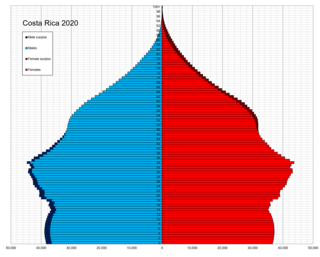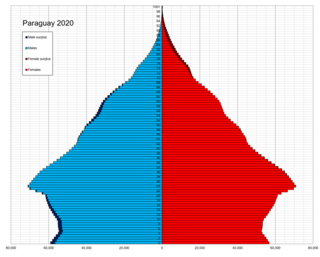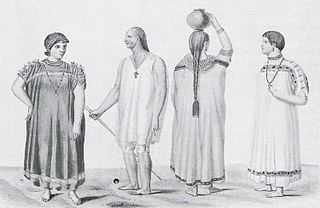Geographic distribution
Geographically, the white and mixed-race populations of Bolivia tend to be centered in the country's eastern lowlands. The white and mixed-race Bolivians in this region are relatively affluent compared to poorer, predominantly Indigenous regions of Bolivia. [4]
1900
According to the 1900 official Bolivian census, a person who self-identified as “Blanca” white was a descendant of a foreigner, principally a Spaniard. This was the last census to ask a more detailed question about ethnic background. [7] Overall there are Italians, Spanish, Germans and French. In total, they represented 12.7 percent of the total population with large populations in Cochabamba (60,605) and Santa Cruz de la Sierra (59,470) representing 36.8 percent combined. [8]
| Departments | Men | Women | Total [9] | % |
|---|
 Beni Beni | 2,981 | 2,132 | 5,113 | 15.88 |
 Chuquisaca Chuquisaca | 15,413 | 16,354 | 31,767 | 15.53 |
 Cochabamba Cochabamba | 28,938 | 31,667 | 60,605 | 18.46 |
 La Paz La Paz | 18,340 | 17,915 | 36,255 | 8.13 |
 Oruro Oruro | 3,996 | 3,778 | 7,774 | 9.03 |
| National territory | 202 | 5 | 207 | 0.64 |
 Potosí Potosí | 11,229 | 10,484 | 21,713 | 6.66 |
 Santa Cruz Santa Cruz | 29,672 | 29,798 | 59,470 | 18.37 [10] |
 Tarija Tarija | 4,368 | 3,816 | 8,184 | 7.95 |
 Republic of Bolivia Republic of Bolivia | 115,139 | 115,949 | 231,088 | 12.72 |
|---|
Mennonites
In 1995, there were a total of 25 Mennonite colonies in Bolivia with a total population of 28,567. The most populous ones were Riva Palacios (5,488), Swift Current (2,602), Nueva Esperanza (2,455), Valle Esperanza (2,214) and Santa Rita (1,748). [11] In 2002 there were 40 Mennonite colonies with a population of about 38,000 people. An outreach of Conservative Mennonites can be found at La Estrella, with others in progress.
The total population was estimated at 60,000 by Lisa Wiltse in 2010. [12] [13] In 2012 there were 23,818 church members in congregations of Russian Mennonites, indicating a total population of about 70,000. Another 1,170 Mennonites were in Spanish-speaking congregations. [14] The number of colonies was 57 in 2011. In the Santa Cruz Department there is an important colony (70.000 inhabitants) of German-speaking Mennonites. [15]

This is a demographic article about Costa Rica's population, including population density, ethnicity, education level, health of the populace, economic status, religious affiliations, and other aspects of the population.

With a population of about 129 million in 2022, Mexico is the 10th most populated country in the world. It is the largest Spanish-speaking country in the world and the third-most populous country in the Americas after the United States and Brazil. Throughout most of the 20th century Mexico's population was characterized by rapid growth. Although this tendency has been reversed and average annual population growth over the last five years was less than 1%, the demographic transition is still in progress; Mexico still has a large youth cohort. The most populous city in the country is the capital, Mexico City, with a population of 8.9 million (2016), and its metropolitan area is also the most populated with 20.1 million (2010). Approximately 50% of the population lives in one of the 55 large metropolitan areas in the country. In total, about 78.84% of the population of the country lives in urban areas, and only about 21.16% in rural ones.

Demographic features of the population of Paraguay include population density, ethnicity, education level, health of the populace, economic status, religious affiliations and other aspects of the population.

Venezuela is a country in South America. The Venezuelan people comprise a combination of heritages, primarily Native American and European. The historically present Native American, Spanish colonists, and African slaves have all contributed to varying degrees. Later, waves of European groups migrated to Venezuela in the 20th century, influencing many aspects of Venezuelan life, including its culture, language, food, and music though small in number.

The demographic characteristics of the population of Bolivia are known from censuses, with the first census undertaken in 1826 and the most recent in 2012. The National Institute of Statistics of Bolivia (INE) has performed this task since 1950. The population of Bolivia in 2012 reached 10 million for the first time in history. The population density is 9.13 inhabitants per square kilometer, and the overall life expectancy in Bolivia at birth is 68.2 years. The population has steadily risen from the late 1800s to the present time. The natural growth rate of the population is positive, which has been a continuing trend since the 1950s; in 2012, Bolivia's birth rate continued to be higher than the death rate. Bolivia is in the third stage of demographic transition. In terms of age structure, the population is dominated by the 15–64 segment. The median age of the population is 23.1, and the gender ratio of the total population is 0.99 males per female.

Mestizo is a person of mixed European and indigenous non-European ancestry in the former Spanish Empire. In certain regions such as Latin America, it may also refer to people who are culturally European even though their ancestors are indigenous. The term was used as an ethno-racial exonym for mixed-race castas that evolved during the Spanish Empire. It was a formal label for individuals in official documents, such as censuses, parish registers, Inquisition trials, and others. Priests and royal officials might have classified persons as mestizos, but individuals also used the term in self-identification.
White is a racialized classification of people generally used for those of mostly European ancestry. It is also a skin color specifier, although the definition can vary depending on context, nationality, ethnicity, point of view, appearance, etc.
Latin Americans are the citizens of Latin American countries.

The Indigenous peoples of South America or South American Indigenous peoples, are the pre-Columbian peoples of South America and their descendants. These peoples contrast with South Americans of European ancestry and those of African descent.

Argentina has a racially and ethnically diverse population. The territory of what today is Argentina was first inhabited by numerous indigenous peoples. The first white settlers came during the period of Spanish colonization, beginning in the 16th century. The Spaniards imported African slaves, who would go on to become the first Afro-Argentines. Following independence from Spain in the 19th century and well into the 20th century, numerous migration waves took place, with Argentina being the second most popular destination for migrants in the early 20th century, after the United States. Most of these migrants came from Europe.
White Latin Americans or European Latin Americans are Latin Americans of European descent.

Chileans are an ethnic group and nation native to the country of Chile and its neighboring insular territories. Most Chileans share a common culture, history, ancestry and language. The overwhelming majority of Chileans are the product of varying degrees of admixture between European ethnic groups with peoples indigenous to Chile's modern territory. Chile is a multilingual and multicultural society, but an overwhelming majority of Chileans have Spanish as their first language and either are Christians or have a Christian cultural background.
White Mexicans are individuals in Mexico who identify as white, often due to their physical appearance or their recognition of European ancestry. The Mexican government conducts ethnic censuses that allow individuals to identify as "White," but the specific results of these censuses are not made public. Instead, the government releases data on the percentage of "light-skinned Mexicans" in the country, which was 47% in 2010 and increased to 49% in 2017. a 2022 survey returns a percentage of 29.2% but it has to be considered that it was conducted with a special focus on socially disadvantaged populations such as Indigenous peoples and Afro-Mexicans. The term "Light-skinned Mexican" is preferred by both the government and media to describe individuals in Mexico who possess European physical traits when discussing ethno-racial dynamics. However, "White Mexican" is still used at times.

The demographics of Colombia consist of statistics regarding Colombians' health, economic status, religious affiliations, ethnicity, population density, and other aspects of the population. Colombia is the second-most populous country in South America after Brazil, and the third-most populous in Latin America, after Brazil and Mexico.

The Mennonites in Bolivia are among the most traditional and conservative of all Mennonite denominations in Spaniard America. They are mostly Russian Mennonites of Frisian, Flemish, and Prussian descent. As of 2013, there were about 70,000 Mennonites living in Bolivia; that population has grown to around 150,000 as of 2023.

Bolivians are people identified with the country of Bolivia. This connection may be residential, legal, historical or cultural. For most Bolivians, several of these connections exist and are collectively the source of their being Bolivian.

The Chiquitano or Chiquitos are an indigenous people of Bolivia, with a small number also living in Brazil. The Chiquitano primarily live in the Chiquitania tropical savanna of Santa Cruz Department, Bolivia, with a small number also living in Beni Department and in Mato Grosso, Brazil. In the 2012 census, self-identified Chiquitanos made up 1.45% of the total Bolivian population or 145,653 people, the largest number of any lowland ethnic group. A relatively small proportion of Bolivian Chiquitanos speak the Chiquitano language. Many reported to the census that they neither speak the language nor learned it as children. The Chiquitano ethnicity emerged among socially and linguistically diverse populations required to speak a common language by the Jesuit Missions of Chiquitos.
White Dominicans are Dominican people of predominant or full European descent. They are 17.8% of the Dominican Republic's population, according to a 2021 survey by the United Nations Population Fund. The majority of white Dominicans have ancestry from the first European settlers to arrive in Hispaniola in 1492 and are descendants of the Spanish and Portuguese who settled in the island during colonial times, as well as the French who settled in the 17th and 18th centuries. Many whites in the Dominican Republic also descend from Italians, Dutchmen, Germans, Hungarians, Scandinavians, Americans and other nationalities who have migrated between the 19th and 20th centuries. About 9.2% of the Dominican population claims a European immigrant background, according to the 2021 Fondo de Población de las Naciones Unidas survey.

In the former Portuguese and Spanish colonies in the Americas, pardos are triracial descendants of Southern Europeans, Indigenous Americans and West Africans.
White Paraguayans or European Paraguayans are Paraguayan people whose ancestry lies within the continent of Europe, most notably Spain, Italy and Germany, and to a lesser extent, Ukraine and Poland.














